Don Tapscott, co-author of Wikinomics, delivered the afternoon keynote at Enterprise 2.0.
 The idea that there is a New Enterprise has been around for a while. It is based on the notion of an open networked enterprise, not a closed hierarchy. Tapscott wrote about this in his 1992 book, Paradigm Shift. “Nothing like and idea whose time has come.”
The idea that there is a New Enterprise has been around for a while. It is based on the notion of an open networked enterprise, not a closed hierarchy. Tapscott wrote about this in his 1992 book, Paradigm Shift. “Nothing like and idea whose time has come.”
Tapscott see four drivers of change:
Web 2.0
The new Web is based on XML, a standard not for presentation, but for computation. The Web is becoming a giant computer and it’s enriched for services.
The Net Generation
Our children are the first generation to grow up digital. They have no fear of technology because to them technology is like the air. It’s all around and it’s just there.
This is the first time in history that children are an authority on something important. And this has led to a situation in which we don’t have a generation gap, but instead have a generation “lap.” And the kids are lapping their parents.
The Social Revolution
This flows from the interaction of Web 2.0 and the Net Generation.
MySpace has eclipsed Mtv. Craig’s List has eclipsed Monster.com. Flickr overwhelmed Webshots.
They are all tapping into people’s instinct to self-organize.
The Economic Revolution
The dot com bubble is being followed by a period in which the real value, the workable solutions and the viable companies are driving an economic revolution. Consider the digital conglomerates: Microsoft, Google, Yahoo, amazon.com, ebay… These are a new species of business.
What’s happening? Wikinomics
Collaboration is beginning to change the architecture of the organization.
We have progressed from the industrial age corporation and practices of Ford and Taylor through the Extended Enterprise of the multinationals through the Business Webs of the 90s to Mass Collaboration.
Today people cannot only socially gather, they can socially produce. Peers outside the boundaries of corporations or corporations acting as peers or peers within the boundaries of a hierarchy can collaborate across boundaries.
This yields the four principles of Wikinomics:
- Peering
- Being Open
- Sharing
- Acting Globally
Consider a company that won by embracing these principles – GoldCorp: A 50 year old mining company peers, opens, shares its proprietary data and acts globally in a bid to transform itself and explore the extent of a rich new find.
New models
Peer Pioneers: Think about Linux. If you can create an operating system through open source, what else can you create in this way?
Ideagoras: Open markets for uniquely qualified minds. Think of P&G, which has opened its problems to solutions from people outside of its corporate walls. Half of P&G’s innovations will come from outside of the company by the end of this year.
Prosumers: Turn your customers into producers. Consider music mashups and remixes. Look at writing the final chapter of Wikinomics through a Wiki.
The New Alexandrians: The sharing of science. Consider the release of the human genome results.
Open Platforms: Consider the Amazon platform. It has over 200,000 delivers attempting to create value on this platform.
The Global Plant Floor: Consider Boeing’s revolutionary approach to create the 787 in partnership with suppliers who shared risk, benefits and development of this revolutionary plane.
The Wiki Workplace: Developing value in the workplace through the application of Wikis and Wiki principals. Consider Geeksquad labelled products at BestBuy.
Crisis of Leadership
This is a paradigm shift. New paradigms are met with coolness and even hostility. Those with vested interests fight the change. And this challenges our leaders to leave that with which they are comfortable.
The time has come for a new Web and a new generation for whom this is their birthright and a new model of how companies and organizations deal with the world.
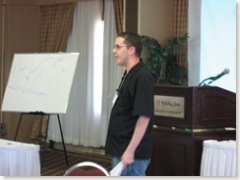 First, you have to make hard decisions. Make choices among the essential tools.
First, you have to make hard decisions. Make choices among the essential tools.
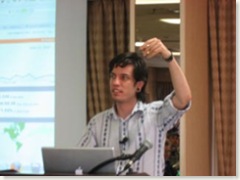
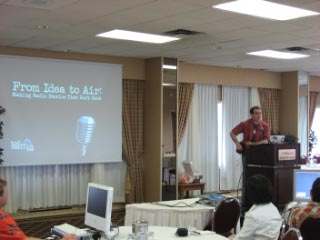 If you haven’t seen Tod give one of his
If you haven’t seen Tod give one of his  Sixty second scenes: Actively listening requires the brain to compose images. Allow time for this to happen. Provide audible “audio on-reamps” – music, an audio effect or even silence – to signal to the listener that they should be ready for a change of scene.
Sixty second scenes: Actively listening requires the brain to compose images. Allow time for this to happen. Provide audible “audio on-reamps” – music, an audio effect or even silence – to signal to the listener that they should be ready for a change of scene.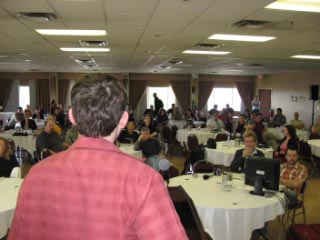 The quest should have not be linear. There should be progress followed by setbacks followed by progress. Drama and comedy rest in the “Gap” between what a character expects to achieve and what they actually achieve. This gap provides reason for the protagonist to attempt a different approach to achieve their objective. And at each turn, the risk increases.
The quest should have not be linear. There should be progress followed by setbacks followed by progress. Drama and comedy rest in the “Gap” between what a character expects to achieve and what they actually achieve. This gap provides reason for the protagonist to attempt a different approach to achieve their objective. And at each turn, the risk increases.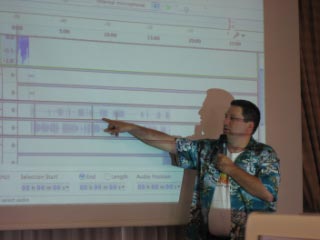

 The idea that there is a New Enterprise has been around for a while. It is based on the notion of an open networked enterprise, not a closed hierarchy. Tapscott wrote about this in his 1992 book, Paradigm Shift. “Nothing like and idea whose time has come.”
The idea that there is a New Enterprise has been around for a while. It is based on the notion of an open networked enterprise, not a closed hierarchy. Tapscott wrote about this in his 1992 book, Paradigm Shift. “Nothing like and idea whose time has come.”